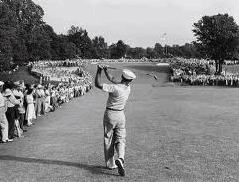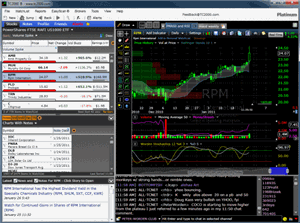Search Results for 'traders'
Practice Winning
In my office hanging on the wall, I have a whiteboard, a plasma TV, some handwritten wisdom my grandfather penned in 1973, artwork from my 3-year old, and a Kenny Rogers poster. A bit random, yes.
Right alongside those things, however, is a large photo of Ben Hogan’s 1-iron approach to the 18th green in the final round of the 1950 U.S. Open at Merion. It set up a 2-putt par to put Hogan in a playoff the following day, which he won for his fourth major title. It’s black and white – which is classic – just like the moment it captures.

Preparation + Confidence = Performance
When I stare at the photo, I’m most impressed by Hogan’s focus. Perhaps the first thing you notice about this famous picture is the gallery lining the entire scene. Thousands had spent their day following him, and with the finish imminent, they stood silent, awaiting the outcome. And with history on the line, Hogan hit a masterful shot – just as he had practiced countless times – as if he weren’t nervous.
But he was human – and nervous indeed. He knew what was on the line. His confidence and preparation simply suppressed the effects of his nerves, so that he could perform his craft and execute with precision the same shot he’d hit many times in solitude.
It didn’t matter that he had to make par. It didn’t matter that he had to hit arguably the hardest shot in golf – fading a 1-iron against a right-to-left wind so the ball would land softer on crusty U.S. Open greens. And it didn’t matter that he was likely exhausted from walking 72 holes on legs which had been battered so badly in a near-fatal car accident just a year prior.
What mattered to Hogan was wrapping himself up in the process, ignoring the buzz around him, forgetting (if not thriving on) the pressure he faced, and relying on his preparation – both physical and mental – in order to produce a great result with controlled emotion.
Repetition is the Mother of Skill
Whether it’s sports or music or any other craft – including trading – there’s no substitute for preparation and practice. Hitting golf balls on the driving range can produce the “muscle memory” needed to groove a golf swing. Standing in the gym and shooting free throws every day will make you better. Watching the order flow, working the charts, and making trades on a regular basis will both train your eye and develop the gut feel you need as a trader. And such things must be done by those who want to get good.
But for those who want to be great, that’s not where it stops.
Both your skills and your mental game must be improved.
 When it comes to skills, you have to hone your existing skills and tighten up any loose ends. Tighten your routine, and increase your discipline with what you know. But you must also build your cache of talents. Learn to operate on other timeframes. Get better at evaluating risk, managing money, and overcoming biases. Become more efficient by learning when to add to winning trades, hop on board existing trends, identify reversals, trade news, and execute with precision. Not surprisingly, these are the same skills which are taught in the Advanced Trading Course.
When it comes to skills, you have to hone your existing skills and tighten up any loose ends. Tighten your routine, and increase your discipline with what you know. But you must also build your cache of talents. Learn to operate on other timeframes. Get better at evaluating risk, managing money, and overcoming biases. Become more efficient by learning when to add to winning trades, hop on board existing trends, identify reversals, trade news, and execute with precision. Not surprisingly, these are the same skills which are taught in the Advanced Trading Course.
Beyond those things, your mental game cannot be ignored. Visualizing literally everything and mentally rehearsing situations and emotions is another key component. Hogan practiced for repetition, but he also practiced with purpose, picturing situations where he’d need to pull off a shot under pressure or with potential distractions.
You must do the same. Make the time every day to take a break and shut everything down around you. Make a list for yourself of situations you might face in your trading, whether a string of losses or wins, or monitoring multiple positions, or the urge to trade when nothing is setting up, or feeling left behind in a market move. Take them one at a time, and imagine what you will do and how you’ll respond.
Picture yourself in control, not in a way that everything does what you want, but in such a way that you’re not feeling panic or fear or distraction from your trading process. Imagine the intensity of each situation having the opposite effect by actually increasing your focus. Starting off, it may just be a couple of minutes, but as you practice and become more skilled at visualizing, you will add more time. And you’ll be amazed what follows.
As you think about your trading, are you able to approach big situations with supreme confidence? Do you need to know more or improve your techniques or get better equipment or become mentally tougher? Then what are you waiting for?
Trade Like a Bandit!
Jeff White
Producer of The Bandit Broadcast
Not a Pattern Day Trader?
The phrase ‘Pattern Day Trader’ has this negative connotation to it which scares a lot of people unnecessarily. It conjures up images of high risk or compulsive behavior, neither of which are entirely accurate.
Many traders have asked me about having the Pattern Day Trader designation out of concern that it puts them in the same light as ‘perpetual liar,’ or ‘drug addict’ or any of the corrupt individuals found on the no-fly list.
Nonsense! Don’t get spooked by a label.
 The Pattern Day Trader designation is simply a category for an account, and therefore doesn’t mean you have any sort of a repetitive disorder!
The Pattern Day Trader designation is simply a category for an account, and therefore doesn’t mean you have any sort of a repetitive disorder!
What It Is
The SEC implemented this classification for accounts, and brokers are required to comply. The restrictions imposed on those without the designation are not a plot against you – your broker is simply enforcing what they’re required to do. Supposedly, the SEC put the PDT rules into effect to protect those with smaller accounts from the ‘high risks’ associated with day trading (as opposed to those ‘other’ high risks found in longer-term ‘investments’ or crossing the street at a busy intersection).
* Personally, I think attempting to pick the next MSFT and holding
hoping for decades it works out is higher risk than the astute day
trader who’s continually limiting his losses, but I digress…
The Pattern Day Trader distinction carries with it two requirements, which are that the account is a margin account, and that it maintains a $25,000 equity balance. Once those are met, you’re free to trade as often as you want, as well as have the benefit of 4:1 intraday margin at your disposal – nice for those who know how to use it.
Those without this account designation, however, have some restrictions. Primarily, they’re unable to make 4 or more round-trip trades in a 5-day period. That really cramps the style of the would-be active trader who has an account below the threshold, and it’s easy to argue that there’s HUGE risk in having your account frozen when the market is on the move.
Get Creative
If you’re one of the traders currently limited in your activity by the Pattern Day Trader restrictions, take heart. You have choices.
The most obvious is to fund your account enough to bring it past the threshold. That’s not an option for everyone, but arguably, even if you didn’t intend to fully utilize the capacity of the account (or day trading buying power which comes along with it), you’re at least free to trade as you see fit with no restrictions.
Supposing that’s not a viable option, there are others, so let’s explore a couple.
* Focus on longer timeframes. There’s nothing that says you can’t trade – only that you can’t trade very frequently! That shouldn’t prevent you from zooming out a bit on your timeframe from multi-hour trades to multi-day trades, ie: swing trading. That approach certainly has benefits – not only does it allow you to sidestep much of the intraday noise and seek out larger moves, but it will of course mean fewer transactions. The lack of churning will also cut down on commissions, which is a nice fringe benefit.
* Consider trading futures. Futures are leveraged, but for the e-mini Nasdaq 100 or S&P 500 futures contracts, margin requirements are pretty low. Futures are also not restricted to the Pattern Day Trader, so activity isn’t limited.
* Look at your options. While the Pattern Day Trader rule still applies to options, one element which many don’t consider is the turnover of capital within smaller accounts to make room for a new equity position. For example, if you’re holding a stock which you don’t necessarily want to dump, yet see another you’d rather have, most likely you’ll exit the old in favor of the new (supposing your account doesn’t have enough equity to hold them both). With options, however, smaller amounts of capital are needed to control an equity position, thus allowing you to have positions in both. Options of course expire, and there are other risk factors to consider if you have no experience trading them, but they do offer an alternative to an either-or equity stance.
The bottom line is that even if you’ve been slapped with the Pattern Day Trader designation, there are ways to be effective without simply buying and hoping. As in many endeavors, a little creativity goes a long way in trading.
Trade Like a Bandit!
Jeff White
Producer of The Bandit Broadcast
Are you following me on Twitter yet?
Choose Your Discomfort
 Trading is not easy.
Trading is not easy.
There…I said it. As if you didn’t already know.
It can be simple, but that’s different. When you’re trading well, it might feel easy, but when the tough stretches arrive again (and they will), you’ll be reminded that it’s hard. As they say, “if it were easy…”
Contrary to what most traders think, the hard part of trading isn’t being right or wrong. Each of us will find ourselves in winning trades and losing trades at times – even random entries can produce (at least temporary) profits. Discomfort is the hard part.
Discomfort in trading can be tied to either profits or losses.
For example…
Our minds seem hardwired to shun (perceived) failure, so some traders struggle in a big way to close out a losing position and instead spend waste time hoping for a turnaround which may or may not ever happen. It’s uncomfortable for them to admit defeat and accept a small loss, so they usually pay big to try and avoid that.
Our minds can also have recency bias, so after a string of losses, it’s tempting to book a winner – no matter how small – just to stop the bleeding and have a taste of success again. It can be uncomfortable to let open profits ride when you’re clearly on the correct side of a trade – what if you give them back?! You need this winner, right? That often leads to booking smaller gains as compared to what you were on track to get paid, and that adds up big over the course of your month, or your year, or your career.
Discomfort can also be tied to our preferred trading timeframe.
Some can’t stand the erratic price action found on the intraday charts, and they tend to respond with late or forced entries when day trading. They get spooked out of good trades, opting instead to focus on the most recent 5-minute bar rather than the overall direction that’s taking place.
Others can’t stand to give a stock an appropriate amount of wiggle room when swing trading, so they choke off what would be a good trade in favor of a stop that’s too tight. Instead of positioning themselves smaller in order to weather the short-term shake-outs, they essentially overtrade by reacting to insignificant moves within the context of a bigger trend. Profits aren’t allowed to pile up, and their skittish approach keeps them frustrated by the big moves they were once a part of but missed out on.
Here’s my point:
Risk involves discomfort, so if you’re constantly avoiding discomfort, you’re avoiding risk – and by definition, risk must be taken in order to profit in the markets. The key is to manage that risk appropriately, which also means managing your discomfort appropriately.
There’s no getting around discomfort in trading. Everyone has it, regardless of directional bias or timeframe preference or the market being traded.
Either you’re uncomfortable with the results you’re getting (e.g. overtrading, not sticking with good trades, staying too long in poor trades), or you’re going to face some discomfort while denying yourself as you stay with a good position. That’s going to include enduring pullbacks, watching some profits evaporate, and being patient while waiting for an acceleration move to occur.
In an instant-gratification society like ours, it’s no wonder most traders fail. Have the courage to choose your discomfort ahead of time, so that by expecting it and mentally rehearsing what you’ll likely face, you’ll in turn be able to respond with good decisions.
Trade Like a Bandit!
Jeff White
Producer of The Bandit Broadcast
Are you following me on Twitter yet?
Reminder: Webinar Tonight 8ET!
Here’s a quick reminder about tonight’s free trading webinar, as I would love to see you there if possible.
Locating Trade Candidates with TheStockBandit
I’m excited to run through a number of interesting chart setups, from both the bullish and bearish sides, in order to teach you some concepts and of course put some quality plays on your radar.
I also plan to share with you a setup that’s been trapping traders lately, which means opportunity for you if approached properly.
The webinar is scheduled to run 45 minutes, with 15 of those minutes set aside at the end for Q&A and a look at your favorite charts.
Visit this link for registration to the 8pm ET webinar:
Locating Trade Candidates with TheStockBandit
See you tonight!
Jeff White
Producer of The Bandit Broadcast
Are you following me on Twitter yet?
Webinar: Tuesday, April 19
I wanted to be sure to invite you to the webinar I’ll be presenting on Tuesday (April 19th) with the folks from Worden – there’s no charge and I hope you can join us!
Locating Trade Candidates with TheStockBandit
 It’s scheduled to be a 45 minute webinar, the first 30 minutes of which I’ll be going through my watch lists, pointing out to you what I’m seeing in the charts for both the overall market and individual stocks.
It’s scheduled to be a 45 minute webinar, the first 30 minutes of which I’ll be going through my watch lists, pointing out to you what I’m seeing in the charts for both the overall market and individual stocks.
There will be 15 minutes of Q&A time at the end where you might want to bring forth your favorite stock and we can take a look at those too.
It’s going to be a chance for me to convey what I’m seeing out there and hopefully not only teach you a few things, but also put many stocks on your radar which you may find of interest.
I’ll also be covering some of the latest developments in how stocks are moving, helping you avoid some of the “obvious” setups which are trapping traders frequently in today’s environment.
Oh, and the best part about it is that this event will be FREE, so be sure to register at this link for details (and access to the recorded version if you can’t attend live):
Locating Trade Candidates with TheStockBandit
Remember: this Tuesday night, 45 minutes of charting reading with you and me – I can’t wait!
Jeff White
Producer of The Bandit Broadcast
Are you following me on Twitter yet?
Consistency Over Time
 It’s been said that good trading is a marathon – not a sprint. I’ve said it too, because I agree. Overnight riches come to very few, but the truly successful usually earn it over time.
It’s been said that good trading is a marathon – not a sprint. I’ve said it too, because I agree. Overnight riches come to very few, but the truly successful usually earn it over time.
Think about it…it takes some time to learn this game, to get comfortable, to evolve to where you’re agile enough and have the discernment to switch styles or approaches when the situation calls for it. A newbie only does that out of desperation. In this game, experience pays.
Truth be told, March has been a tough month for me. I’ve been whipped out of some trades, bought some highs and sold some lows. Naturally, it has elevated my frustration level. The good news is that I’ve been here before. I’ve had those months where I have struggled, and every time I’ve been able to battle back – thankfully. This time should be no different.
I’ve looked over some trading results today, and it was a good exercise. I was reminded that there are occasional stretches where I give some back to the market. But they’re just little phases, and they’re inevitably followed by good runs – so long as I keep after it. I don’t have to make huge bets and get it all back in one trade, and I also don’t have to force trades in order to see my account back at highs. I simply need to keep a level head and persist.
Ask any distance runner, and they’ll tell you it’s all about maintaining a steady pace. The hills hurt, like losing trades, but you maintain your tempo and push through it. Cadence is important to cyclists, so they shift gears along the way in order to maintain that rhythm.
Similarly, you and I size up when we’re in the groove, just a runner takes longer strides going downhill or a cyclist shifts to high gear. When the road gets rougher or tougher on us, we scale back our size but we keep taking One Good Trade – that’s our job.
Trading at times feels like a fun run…achievement comes easy and you get the t-shirt as a bonus! At other times, it feels like an ultramarathon for which you aren’t prepared. Fortunately, we have the chance to rest along the way, and improve as we go. Attitude is key, as is taking a long-haul approach with our career as traders – even if we love short-term charts!
How are you running your race?
Trade Like a Bandit!
Jeff White
Producer of The Bandit Broadcast
Are you following me on Twitter yet?
4 Reasons to Be in Cash This Weekend
 Last week, I closed out a few swing trades and shifted to cash. I’m glad. I’ve day traded and it’s been a good week, and I didn’t need to roll the dice overnight in order to turn a profit.
Last week, I closed out a few swing trades and shifted to cash. I’m glad. I’ve day traded and it’s been a good week, and I didn’t need to roll the dice overnight in order to turn a profit.
Heading into Friday, I think there are 4 good reasons to remain in cash over the weekend:
1. Busted Patterns. Simply put, right now for most stocks it’s too late to short (for the initial selloff anyway), and it’s too early to go long. For me, the smaller the pattern, the shorter the timeframe for the trade I’ll take from that pattern. With this week’s sudden shift of direction and the intensity of this initial pullback, whatever had been looking bullish (sans energy) now isn’t, and whatever had been looking bearish has cracked like the Liberty bell. Most patterns out there are 3-bar setups, which means I’ll day trade them if they confirm but otherwise will allow them to mature further (read: sit on your hands and wait).
2. Added Uncertainty. Heading into a 3-night, 2-day stay in the heart of Uncertaintyville isn’t great for capital preservation. Holding overnight always involves uncertainty, but when we’re in an environment which is so sensitive to geopolitical events in the Middle East, it has more of an earnings announcement feel to it. One of my trading rules dictates that I avoid holding positions into earnings since I have no edge, and because it makes risk management so difficult impossible. Right now, gap risk is running higher, so when the setups aren’t there (see #1 above), why hold overnight?
3. Change of Character. Every dip has been bought…until this week, which is to say the landscape has shifted a bit. That’s not bad, and it doesn’t mean the bull market is over. What it means is that the multi-hour pullback has been stretched into at least 1 multi-day pullback. We’re getting more back-and-forth, which is more commonly associated with a trading range than a trend. The market’s taking a much-deserved breather here at the very least, and we need to respect that.
4. Better potential ahead. There are a few setups I’m watching for Friday’s session, but the truth is that I expect much better opportunity to surface next week when it comes to swing trading. A couple of bars go a long way when patterns are developing, and right now that’s just what many stocks need. I expect we’ll see that take place next week, so I’d rather have the peace of mind and lack of risk than to fret over the weekend about what a potentially hurtful gap would mean.
Once the dust settles ‘over there,’ we’ll have some better patterns and spots to pick and choose from. And the good news is that volatility is increasing, which means more movement anyway – always a great thing for short-term traders like you and me. So enjoy your weekend and rest up, next week is sure to be another interesting one and we’re going to need to show up ready!
Trade Like a Bandit!
Jeff White
Producer of The Bandit Broadcast
Are you following me on Twitter yet?





